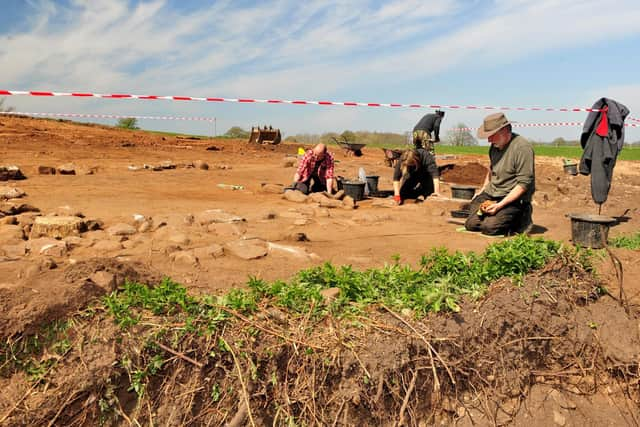Builders discover remains of medieval farmhouse on land in historic village near Harrogate during site works
Contractors preparing former agricultural land at Lawrence House Farm in Scotton for the building of five new homes discovered the foundations and work has now been halted while North Yorkshire County Council archaeologists explore the site.
They believe they have found the remains of a dwelling and associated outbuildings that belonged to a self-sufficient farming family in the 13th to 16th centuries.
Advertisement
Hide AdAdvertisement
Hide AdThe find has excited Scotton residents, who only three years ago undertook their own archaeological survey of several farms surrounding the village, which is rich in heritage from the Bronze Age to the Gunpowder Plot - it was where Guy Fawkes lived as a teenage boy.


Lawrence House Farm's owner did not take part in the project run by the Claro Community Archaeology Group in 2018 and local experts believe there could be other remains on the land.
Nigel Harper, who has spoken to archaeologists working on the development site, said: "At first, they thought it was a single room dwelling, but now they think it's more complex, with other sections and a bigger building. They've narrowed it down to between the 1200s to the 1500s, and they've turned up a few items such as glassware and pottery, including a shard that is of special interest.
"It would have been agricultural land and the occupants would have been self-sufficient, middling sorts who were reasonably comfortable - it wasn't a peasant hovel. It looks to be the size of a small modern home, and they've found the remains of a hearth."
Advertisement
Hide AdAdvertisement
Hide AdThe dwelling would have been close to today's High Moor Lane, an old route which runs into the village and is lined with properties dating from as far back as the 1500s.
"There's also the outline of a large rectangular structure on Lawrence House land, which nobody has been able to investigate yet and so its origins are unknown.
"The village has a long and complicated history. St Thomas's Church was built on a Bronze Age burial mound which was destroyed in the 1800s. and we think the Roman road from Aldborough to Chester passed close by.
"Many of the fields haven't been ploughed up and you can still see the outline of the medieval open field pattern."
Advertisement
Hide AdAdvertisement
Hide AdHowever, Mr Harper has been told that once the site has been investigated and finds recorded and catalogued, it is likely to be built over.
"It will be lost, as it's not of high enough significance to be listed as a Scheduled Ancient Monument."
Comment Guidelines
National World encourages reader discussion on our stories. User feedback, insights and back-and-forth exchanges add a rich layer of context to reporting. Please review our Community Guidelines before commenting.